- Activity tracking
- Setting goals: Fitbit wins
- Heart-rate monitor: narrow Fitbit win
- Checking heart irregularities: Draw
- Checking blood oxygen (SpO2) levels: Apple win
- Calorie counting: draw
- Sleep monitoring: Fitbit win, Apple improving
- Apps: Fitbit wins on fitness, Apple on everything else
- Music: Apple wins
- Screen: Apple wins
- GPS: Apple wins on built-in
- Phone calls on your wrist: Apple wins but Fitbit catching up
- Battery life: Fitbit wins, no contest
- Rewards: Fitbit loses its medal, Apple wins
- Find My…: Apple wins, Fitbit catching up
- Comparing all the models: Apple Watch vs Fitbit
- Price: Apple getting cheaper
- Compatibility: Apple is iPhone only
- Hearing: Apple wins helping your ears
- Fitbit Premium vs Apple Fitness+
- Which should you buy: Fitbit or Apple Watch?
Want a fitness tracker but can’t decide between a Fitbit wristband and the rather beautiful Apple Watch, now in Series 8? We compare the Apple Watch vs the Fitbit to see which performs best in terms of exercise tracking, heart-rate monitoring, design, price, apps, battery life, phone conversations, audio, and so on.
Fitbit is known for its activity monitors and fitness and health wearables, while Apple is known for its smartwatches. However, the lines between functions and devices are blurring, with Fitbits resembling watches with appealing touchscreens and Apple adding more health features to its Watch.
Even though the smarter Sense and Versa Fitbits do not run multiple apps like a smartwatch, they are directly comparable in many fitness-measuring functions, design themes, and functions. And, to be fair, the most popular non-fitness apps on most smartwatches include on-wrist notifications such as Caller ID, Texts, and WhatsApp.
Both Apple and Fitbit make excellent products, so it’s a matter of deciding which features really matter to you. We will focus on health and fitness as a core requirement, but there is more to both brands than just these functions.
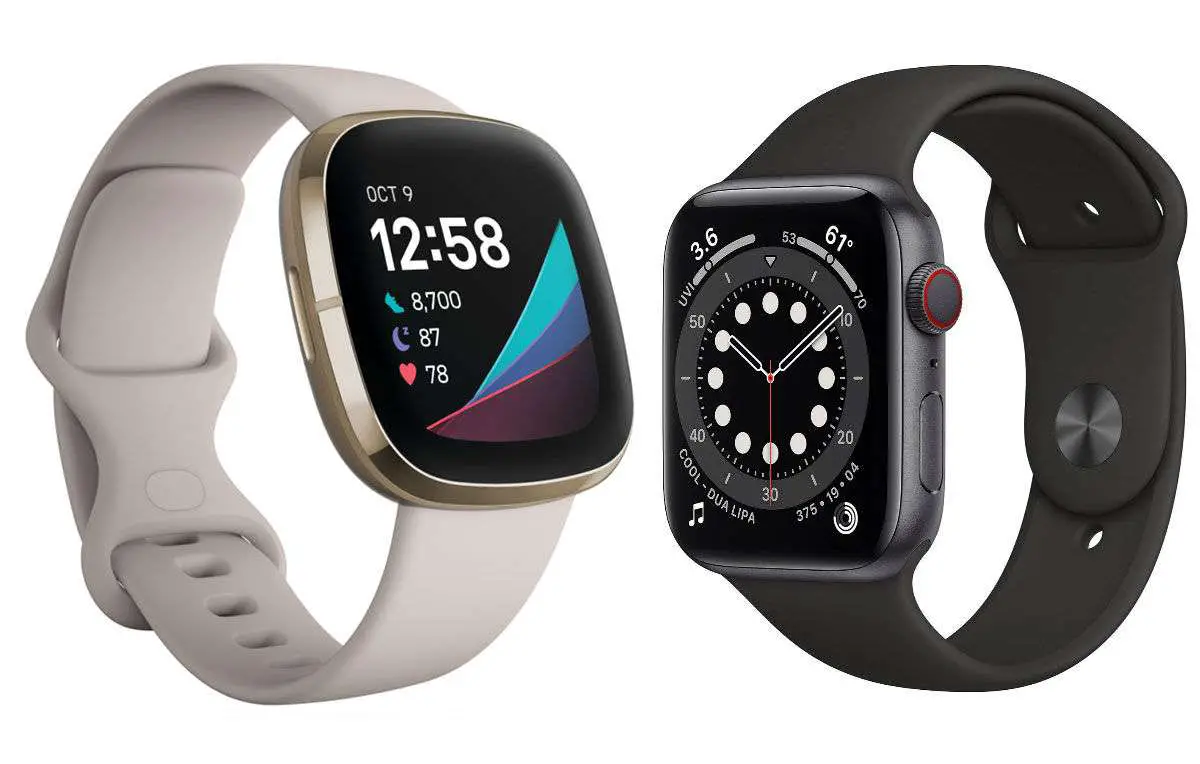
Activity tracking
Keeping healthy does not require you to be a gym rat or a race competitor. Keeping active throughout the day has actual health advantages as well, and both the Apple Watch and Fitbit fitness trackers are excellent at encouraging you to move more.
Steps taken, distance traveled, and calories expended are all measured by the Apple Watch and Fitbit fitness monitors. They also display the number of minutes you were busy during the day. Each monitors your progress over time and stores previous data, and you establish daily objectives for yourself.

Furthermore, the Apple Watch Series 6 and later, as well as Fitbit trackers (except the Versa Lite Edition), all include a barometric barometer that tracks distance ascended (take the hilly route home, not the flat one). Fitbits can also share weight data from optional Fitbit Aria scales, whereas the Apple Watch works with any other health and fitness software that syncs with Apple Health on iPhone.
As a consequence, Fitbit models vary from daily fitness to active fitness (similar to the Apple Watch) to sports and performance fitness, with the Charge 5, Sense, and Versa 3 and 4 enabling running, cross-training, bicycling, strength, and aerobic routines.
Serious runners eschewed the initial Apple Watch and Fitbit in favor of the Ionic or other specialized running watches from Garmin or Suunto. That changed with the introduction of the Apple Watch Series 2, which included an in-built GPS like the Fitbit Charge 4, Versa 2/3/4, and Sense.
The Watch Series 3 and Watch Series 8 have faster processors (the latter’s engine is much faster, so applications run quickly) but still have poor battery life, with typical battery life of 18 hours. A variant with built-in 4G is also available, allowing you to workout without having to bring your iPhone with you.
This brings it closer to the Fitbit Sense and Versa 3 & 4, which (with comparable built-in GPS, audio settings, alerts, and contactless payments) can handle the majority of your exercise requirements without requiring you to tote around a phone or money. Fitbit’s newest Versa 4 and Sense 2 smartwatches, unfortunately, removed many applications and audio controls.

The Fitbits are clearly focused on fitness, whereas the Apple Watch includes exercise monitoring among its many features.
The Apple Watch comes with two exercise apps: Activity, which focuses on health, movement, wellbeing, and your everyday regimen, and Workout, which records jogging, cycling, and walking. All of this data is gathered on your iPhone via the Activity app, but you can get a more comprehensive picture of their health by using the Health app, which combines data from multiple sources, not just the Watch.
Apple measures activity and calorie expenditure rather than steps, which is the main number used by Fitbit—though Fitbit also measures calories and other metrics. For consumers aged 13 and under, Apple prioritizes activity over calories.
Read also : The best fitness trackers 2023
Fitbits, while excellent with the iPhone, do not formally enable Apple’s Health Kit.
The Apple Watch’s colorful three rings, which light up to indicate your progress, allow you to see how far you are with your daily activity and health objectives at a glimpse. The Move band displays the number of calories expended. The Exercise band indicates how many minutes of vigorous exercise you’ve completed. And the Stand ring indicates how frequently you’ve stood up to avoid reclining down. The goal is to finish each circuit every day. It’s an excellent motivator.
Apple describes exercise as any action that is at least as strenuous as a brisk walk. Because the Watch analyzes your heart rate and activity data, going for a stroll may not move that green band as much as you imagine. It desires your heart to beat a little quicker. The Apple Watch learns your routines and will drive you stronger as you become more active over time.
We like how the Apple Watch will ping you if you’ve been seated for too long—time it’s to stretch your legs and get your pulse rate up, or at the very least rise up. From the haptic pulses on your watch to alerts, it’s essentially a wake-up signal that you’ve been sitting for an extended amount of time. You can actually get an alert while standing up because the Watch is tracking your absence of movement.
Fitbit’s Reminders To Move feature functions in the same manner and is available on all Fitbits.
The Apple Workout app provides real-time stats for exercise time, distance walked/run, calories burned, and pace, and while it was initially difficult to use, a redesign means it’s not only easier to use, but also now works with 80% of gym equipment, so you’ll get data from the running machine or bike you use at your local.
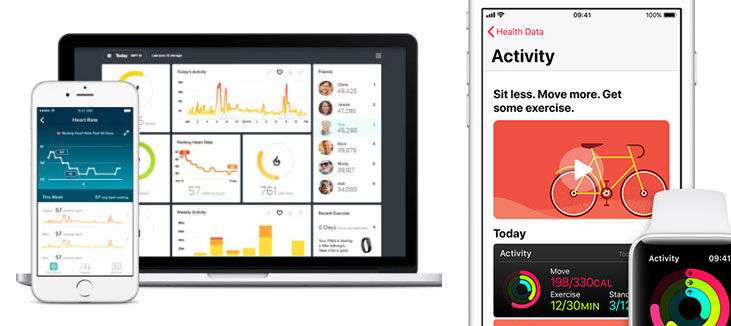
Setting goals: Fitbit wins
With the exception of calorie burn, Apple does not allow you to establish objectives for steps or other metrics. If reducing calories is not your primary goal, this is a significant drawback of the Watch.
Fitbit, on the other hand, enables you to establish precise objectives for Steps, Distance, Calories Burned, Active Zone Minutes, Floors Climbed, and Hourly Activity Goal.

Heart-rate monitor: narrow Fitbit win
Apple Watch and heart-rate monitoring Fitbits detect your pulse rate using a technique known as—deep breath—photoplethysmography. This employs green LEDs on the wristband’s bottom to sense variations in blood volume and capillary size under pressure. When your heart pulses, your capillaries enlarge and constrict in response to variations in blood volume. The LED lights reflect on the epidermis and sense variations in blood volume.
Because blood reflects red light and consumes green light, it is crimson. When your pulse beats, the blood flow in your wrist increases, as does the absorption of green light.
Fitbits constantly track your heart rate 24 hours a day, seven days a week. During activity monitoring, they can retain heart rate data at 1-second intervals and at 5-second intervals at all other times.
The Apple Watch, on the other hand (or should I say wrist?) monitors your pulse rate every ten minutes during the day. When the Workout app is switched on, it does, however, constantly capture your pulse rate, so you get constant input during training sessions. The built-in heart-rate sensor on the Watch also supports external heart-rate devices.
Apple has enhanced the Heart Rate app, which now monitors your idle and recovery heart rates and can notify you if anything is wrong.
The Apple Watch Series 8 arrives pre-installed with watchOS 9. Car crash detection, Heart Rate Zones, customizable workouts, a Multisport workout that automatically switches between any sequence of swimming, biking, and running; Race Route, which lets you compete against your best time running or biking a familiar route; Automatic track detection; Running Form metrics; Running Power; Medication logging and reminders; Sleep Stages; AFib History; Temperature changes are among the new features and improvements in watchOS 9.
Fitbit claims that the Sense and Versa 3 have better heart-rate monitoring because the LED sensors are closer to the wrist.
The Apple Watch can detect and advise of an extended elevated heart rate when not exercising, and it can also detect low rates (which could be a sign of bradycardia, when the heart is not pumping enough oxygen-rich blood around the body). It also detects irregular cardiac beats and alerts you to the possibility of atrial fibrillation.
Patients who visit physicians frequently complain of heart issues that aren’t present at the time, so having comprehensive and long-term heart data on file in the Health app could be helpful.
Let’s take a closer look at these heart sensors and how they can identify sickness.
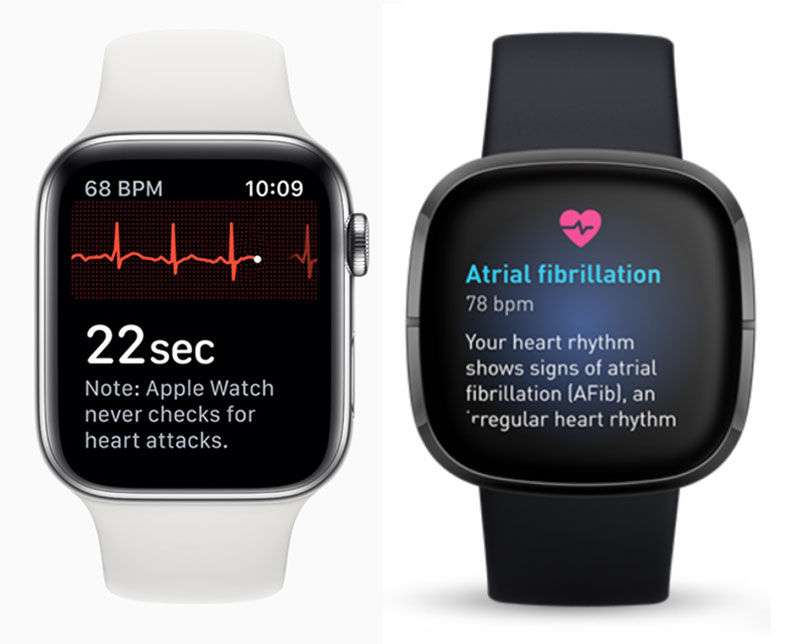
Checking heart irregularities: Draw
Measuring heart rate also enables devices to detect irregular heart rhythms, which can be a symptom of atrial fibrillation (AFib), a major cause of stroke.
Apple and Fitbit both include the ability to detect an individual’s electrocardiogram (ECG) output.
EKG readings are available on the Fitbit Sense and Apple Watch. For example, by pressing your finger against the Watch’s Digital Crown, you can instruct it to perform an electrocardiogram (ECG) examination on you.
In the European Economic Area, each ECG software is CE stamped and passed, and in the United States, it is FDA-approved.
It should be noted that the US International Trade Commission has determined that the Apple Watch infringes on ECG rights from medical device firm AliveCor, which could be a potential roadblock for this technology.

Checking blood oxygen (SpO2) levels: Apple win
The proper equilibrium of blood-oxygen concentration is critical for good health.
Hypoxemia is a disease characterized by low blood oxygen levels. Most people do not have persistent health conditions that necessitate monitoring their blood oxygen level (asthma, heart disease, and chronic obstructive pulmonary disease), but if you do, having a SpO2 gauge will be extremely beneficial.
A usual SpO2 measurement is between 95 and 100 percent.
SPO2 sensors are available in both the Apple Watch and the most recent Fitbit wearables to measure blood-oxygen saturation. Both enable for on-demand blood oxygen readings, but Apple’s approach is more adaptable.
The new Apple Watch can take a blood O2 measurement in 15 seconds at any time of day, whereas Fitbit only monitors your blood-oxygen levels while you slumber and requires you to remember to swap the clock face in order for it to take a reading unless you subscribe to Fitbit’s Premium service.
Fitbit users will need a Premium membership to monitor patterns over time in the Fitbit app’s Health Metrics interface.
You can also read about the best connected watch

Calorie counting: draw
The fundamental weight-loss strategy is to measure calories in and ensure that you are expending more calories out through exercise. The Watch and Fitbits both assist you in counting calories.
The Apple Watch calculates calorie tally using activity and heart rate data, which then determines the Move metric of the Activity app. As you continue to wear your Apple Watch, it will learn your habits, typical heart rate ranges, and regular exercise levels, allowing for more accurate calorie counting.
Unlike Fitbit, Apple distinguishes between “stationary calories” (calories burned simply by living) and “active calories” (burnt through more vigorous activity). The Move band is more concerned with Active calories rather than Sitting calories, which is a little more stringent than Fitbit’s method. Fitbit also has “resting energy” available.
Your Resting Metabolic Rate (RMR) is the number of calories your body uses while at rest (with muscles relaxed, such as sleeping) to keep itself living (support critical systems like your heart, brain, nervous system, lungs, kidneys, liver, muscles, and epidermis) and process food. (Technical note: Resting Metabolic Rate (RMR) differs from Basal Metabolic Rate (BMR), which eliminates calories expended digesting food.)
If you put your Apple Watch calorie-burn target to high, you’ll need to walk the equal of 20,000 Fitbit steps.
The Versa and Sense, for example, detect when you’re jogging and instantly engage Run Mode—starting the GPS or connected GPS—and even pause when you do. The most recent Apple Watch models do the same thing.
Fitbit calculates the amount of calories expended based on your BMR (Basal Metabolic Rate), which is determined by your height, weight, age, and gender. Heart rate trackers go into greater depth, with the calorie burn calculation taking heart rate into consideration.
Fitbit calorie tracking starts at midnight and includes calories burned while sleeping, which the Apple Watch, which must charge overnight, clearly does not. When you sync your tracker, Fitbit replaces the predicted calorie expenditure with the data from your device.
You can also directly enter exercise activities so that the calories burned during those activities are recorded. When you enter your meals each day, you can create a Fitbit Food Plan that calculates your daily calorie intake and keeps track of how many calories you’ve expended and ingested so far in the day.
![]()
Sleep monitoring: Fitbit win, Apple improving
Scientists are increasingly connecting sleep disruption to weight increase and bad metabolism, so having a good night’s sleep should be part of your health, fitness, and weight-loss plan. Sleep deprivation has been linked to a rise in the frequency of diabetes and obesity. We should all try to get at least 8 hours of slumber per day.
Eight hours is a worthwhile goal, but it is impractical for many people (including parents!). You may find that a target of 6 to 7.5 hours is more achievable.
Because the Watch’s battery life is restricted (see below), Apple suggests charging it every night. The Apple Watch’s battery life has greatly improved, and it can now last nearly three complete days and two nights on moderate, non-GPS use. To get anywhere close to this level of battery life, you’ll need to cease recording exercises, limit your app usage, and switch off the always-on display.
However, this is not as remarkable as the Fitbit battery life, which can last for a week or more between charges.
Apple introduces a Sleep program to the Series 3, 6, 7, 8, and entry-level SE Watches with watchOS 9. It assists you in developing a consistent nighttime ritual and tracking your sleep patterns night after night.
Apple Sleep detects micro-movements with motion sensors, heartbeat sensors, and mics to determine how profoundly users are asleep. The Watch will connect with the iPhone or iPad to display visualisations of alert and sleep times, as well as a map demonstrating weekly sleep patterns. Apple enhanced the service with the inclusion of breath rate monitoring in watchOS 7 and later.
As my colleague David Price explains in his otherwise glowing Apple Watch 8 review, comparing Apple’s Sleep program to Fitbit’s is illuminating. Despite his love for the newest Apple Watch, he used to sleep with a Fitbit! He is more pleased with watchOS 9’s slumber tracking: “This year, Apple Watch’s sleep monitoring function has improved significantly. I’ve previously grumbled that it’s far less complex than competitor devices’ monitoring, but now you get broken-down periods for Awake, REM, Core, and Deep sleep stages, as well as approximations of the real sleep you’ve had rather than the time spent in bed.”
If you monitor your sleep with the latest Fitbits, you can see a log of the Sleep Stages you cycle through at night. Each night, your body goes through several sleep cycles: light sleep, deep sleep, and REM sleep, which is linked with thinking.
Fitbit gets into much greater depth about the various Sleep Stages you go through, and it now provides a nightly Sleep Score on the quality of your slumber.
Traditionally, sleep stages are monitored in a lab using an electroencephalogram to identify brain activity as well as other devices to track eye and muscle activity. Fitbit trackers can’t compete with this degree of medical precision, but they can predict your sleep stages every night.
Fitbit calculates sleep phases by analyzing movement and heart-rate trends. While you slumber, your device monitors the beat-to-beat variations in your heart rate, known as heart rate variability (HRV), which vary as you move through the phases of light sleep, deep sleep, and REM sleep.

Apple, like Fitbit watches, uses the accelerometer and heart rate monitor on the Watch to identify when you’re in REM, Core, or Deep sleep phases, as well as the fundamental sleep time that the Apple Watch already has. In the Health app, users can examine comprehensive information about the duration and quality of their sleep, as well as additional measures such as heart rate and respiratory rate, in sleep comparison plots. This can aid in the diagnosis of possible disorders such as apnea.
Apple Watch 7 and later now support fast charging, and it will prompt you to power it before going to night.
However, if Apple is to be as successful in this crucial health measurement as Fitbit, it must significantly improve the Watch battery life.

Apps: Fitbit wins on fitness, Apple on everything else
Of course, Apple’s Activity and Workout apps are beautiful, but Fitbit’s attractive multi-phone app includes more fitness metrics and data visuals. Fitbit also has a robust PC interface for collecting and organizing your exercise data.
The Versa 3 and 4 as well as the Sense 1 and 2 are compatible with the Fitbit Coach and Premium, which mix interactive video exercises with Audio Coaching lessons to help users improve stamina, speed, and technique. Fitbit’s Premium service, which costs £7.99 or $9.99 per month, will expand to include sophisticated tools and a collection of programs and exercises to offer customized adaptive health and fitness guidance.
Apple has its own Fitness+ service, which includes workouts and trainers for £9.99 or $9.99 per month and is compatible with most Apple products, including the Mac, iPad, and Apple TV. Though the selection was originally restricted, it has since grown to include Yoga and HIIT.
If the Versa and Sense had a much broader variety of non-fitness applications, they might outperform the Apple Watch. Outside of Fitbit’s remarkable health and fitness functions, as well as notification features, its apps are currently very restricted.
Fitbit is essentially reversing its app strategy, removing the majority of them from its newest wearables, the Versa 4 and Sense 2. Google, Fitbit’s owner, is moving wearable customers to its newer Pixel wristwatch, which includes Fitbit.
If you want a wide variety of non-health applications, the Watch or an Android equivalent will be more suitable than a Fitbit, though they do feature Caller ID, text message, and calendar notifications on screen.
Wearing both the Watch and the Versa and the Sense, we discovered that the most frequently used Apple Watch applications were Notifications, which are also managed competently by the Fitbit smartwatches—albeit in a less graphic manner by the less-smart Fitbit trackers. If the Apple Watch has a “killer app,” it’s presumably Activity—so, despite having fewer third-party apps, Fitbits vie very effectively for the most-used daily apps.
Calendar, Camera Remote, Weather, and Apple Maps are among the other Apple applications. There’s also a plethora of third-party applications for the Apple Watch.
You can also use the Watch to make an album of pictures saved on your watch and share it with others. You can also use one of your pictures as the backdrop for a Watch face.
Fitbits are almost entirely focused on exercise aspects. Furthermore, the Inspire 2 & 3, Charge 5, Versa 3 & 4, and Sense all include Caller ID and Text alerts, as well as the ability to buzz and display who is calling when your phone (iPhone, Android, or Windows Phone) sounds.

Music: Apple wins
If you use Apple Music, you can do a lot with audio on the Apple Watch. You can add music to your library, delete songs, indicate what you like, queue tracks, listen to an artist’s music, and examine the contents of albums and playlists.
You can listen to music saved on your Apple Watch by scrolling through record artwork and then tapping a collection or album to play it.
When using Spotify on the Apple Watch, you can also play, stop, and skip music and podcasts; adjust intensity; explore playlists and tracks; add songs to your Spotify collection; get information about what’s playing; and save your faves.
Fitbit’s audio choices are determined by the type of the smartwatch. Previously, you could transfer 2.5GB of audio (approximately 300 tracks) or podcasts to the Ionic, Versa, and Versa 2. However, the Sense and Versa 3 can only access the rare premium music services Pandora and Deezer, or use the watch to manage Spotify Premium on your phone.
Fitbit has taken another step back with the Versa 4 and Sense 2, which do not include any audio settings.
Apple easily triumphs for real offline audio storage on the wearable — but only if you use its Music service or Spotify.

From the basic Sport to the Watch Hermès Edition, there are numerous permutations of Apple Watch kinds, sizes, and straps. Apple’s Jonathan Ive (who has since left the company) achieved another design triumph with the Watch, and it’s quite lovely. The Watch has an enormous selection of wristbands, and users laud their durability—older Fitbit bands used to fail more frequently.
Fitbit’s tracking wristbands are much simpler, with basic displays (see below) and stark straps available in a variety of hues. Fitbits like the Inspire 3, Luxe, and Charge 5 can be worn alongside a regular timepiece, but I wouldn’t wear an Apple Watch alongside a standard wristwatch on the same arm—the Versa and Sense are the same.
The Apple Watch is your primary timepiece, not a bracelet. Of course, the Fitbit Charge 5 or Inspire 3 can be worn as your only watch, but they can be worn higher up the forearm if you still prefer your normal timepiece.
Strap options: The Fitbit Versa (below) and Sense appear similar to the Apple Watch, but have a smaller but still adequate selection of straps—in a variety of hues in Small and Large sizes. There are additional premium bands available at an additional cost: stainless steel links or mesh, as well as leather.
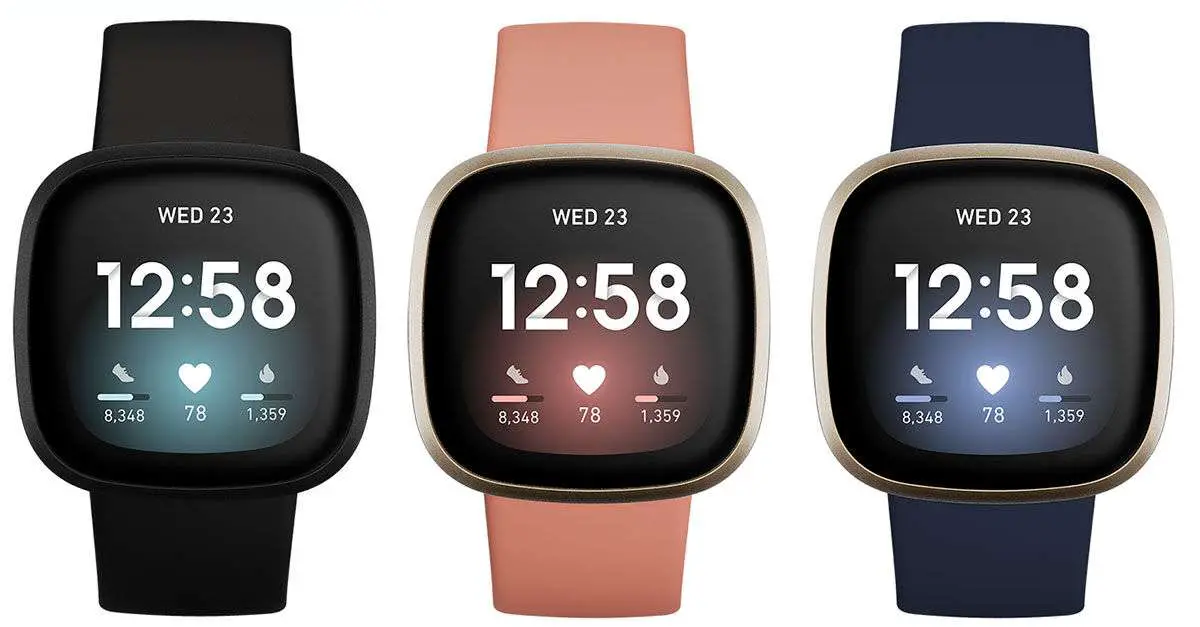
If you want a monitor that looks like a watch, consider the Apple Watch, Fitbit Versa, or Sense. We discovered that the slimmer Fitbits were the most comfy of all the wearables we tried.
The Fitbit Inspire 3, Luxe, and Charge 5 are also comfy, and because they are so light, it’s difficult to tell you’re wearing one at all.
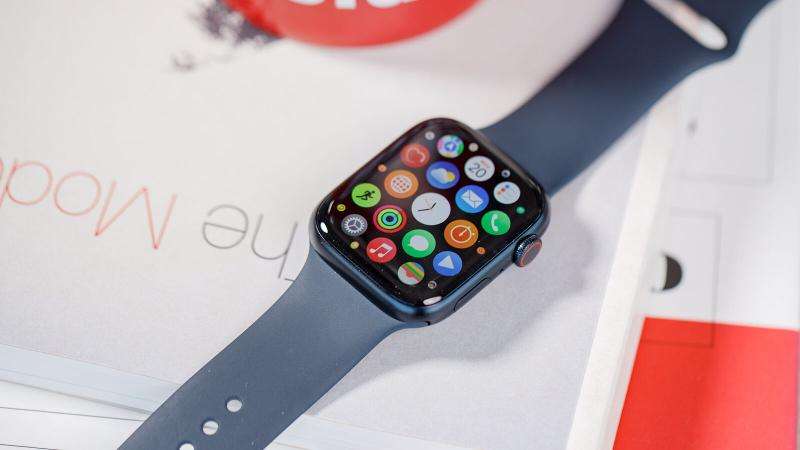
Screen: Apple wins
Apple Watch vs Fitbit specs and dimensions : The Fitbit Sense and Versa trail the smaller form of the Apple Watch Series 8 by a hair. Both Fitbits have a 1.58-inch monitor with a resolution of 336 x 336 pixels, whereas the 41mm Apple Watch Series 8 has a 1.69-inch display with a resolution of 430 x 352.
The Sense and Versa 3 pebbles are 40.48mm in size.
Fitbits all have AMOLED displays, which provide deeper blacks and crisper features than the original Versa.
With the Series 7, the Apple Watch touchscreen grew from 40mm and 44mm to 41mm and 45mm, respectively, where it remains with the Series 8. While it may not seem like much, there is a 20% rise in total display area when paired with reduced bezels.
The new Apple Watch 8 is available in two sizes: 41mm (430 x 352 pixels) and 45mm (484 x 396).
The resolution of the 40mm Apple Watch SE is 324 x 394. The resolution of the 44mm Apple Watch SE is 368 x 448.
The Apple Watch’s display is a work of art in color. The Versa and Sense’s color displays aren’t as rich as Apple’s, but they allow for more than the basic looks of the other Fitbit activity trackers—the Inspire 3, Fitbit Luxe, and Charge 5 all have a tiny but color screen.
Because the screen is tiny, you may prefer to navigate using the Apple Watch’s Digital Crown because your finger will encompass a large portion of the display. Swiping, on the other hand, works wonderfully and is accessible on Fitbit’s Charge 5, Luxe, Versa, and Sense models.
Apple also provides customizable watch faces, ranging from digital and analog chronometers and picture backdrops to Siri-powered watch faces and more, with an ever-expanding collection of faces. There are also a variety of complications available from both Apple and third-party applications, enabling you to quickly access information such as the temperature, air quality, and more.
The Ionic allows you to choose from a variety of watch faces and even create your own, but it lacks complexity.
The Watch performed admirably in US Consumer Reports tests to determine how scratch-resistant its screen is. The Sport edition was immune to all but a masonry drill tool, and the top Watch’s Sapphire screen could not be scratched! The Ionic’s screen is also remarkable, with iPhone-like Gorilla Glass.
Only the Fitbit Versa and Sense, as well as the Series 6, 7, and 8 plus Ultra of Apple Watch, have an always-on screen, which is useful during workouts or bike trips when you don’t want to raise your wrist to your face.
Fitbit, on the other hand, adheres to its basic digital display on all but the Sense and Versa, which can show alternative faces if you prefer it. However, the Fitbits’ less flashy screens result in significantly longer battery life when compared to the rapidly tiring Apple Watch.
GPS: Apple wins on built-in
The initial Apple Watch didn’t have built-in GPS; instead, it connected with your iPhone and used its GPS. That was an issue for runners who were not using an enclosed treadmill. Yes, you can run with your phone, but the Watch promotes itself as a devoted fitness gadget, and without GPS, it’s not suitable for runners. With the Series 2, that issue was addressed, and the current Series SE and 8 all have GPS built in.
Using the Watch’s GPS, you can choose from local hikes, receive notifications about scenic spots along the way, avoid going off the path, and document your activity monitoring.
The Apple Watch Nike+ is specially intended for athletes, with a lightweight aluminum frame, an active watch display, and a perforated Sports band for improved airflow. While jogging, you can choose between a distraction-free display of the distance and your pace and an advanced option that provides more information about your exercise.
For accuracy, the top-tier Apple Watch Ultra includes a dual-frequency GPS.
Utilizing GPS consumes battery life, which the Watch does not have in abundance. Serious joggers are probably better off with a specialized runner’s watch from a company like Garmin, but the Apple Watch is now a legitimate competitor.
GPS is also integrated into the Fitbit Versa, Sense, and non-smartwatch Charge 5.
The Fitbit Versa Lite, Versa 2, Luxe, and Inspire 2 & 3 require a smartphone connection for GPS capability, but they will work with iPhone, Android, and Windows Phone, as opposed to the Apple Watch, which is only compatible with iOS. The Ionic does have a built-in GPS, which, as previously stated, will switch on immediately when it detects that you have begun a run.
To get comparable features to the other Fitbits, download the MobileRun software, which allows you to monitor runs, walks, and treks using GPS. The MobileRun function is accessible to all Fitbit app users with GPS-enabled smartphones running the iOS, Android, and Windows Phone apps.
The Apple Watch can also be linked to other iOS applications that use the iPhone’s Location, such as MotionX GPS and RunKeeper.
Fitbit’s Multiple Sport Mode allows you to monitor your riding as well (distance, location, average speed, heart rate and calories burned).
The Apple Watch’s Maps program, on the other hand, is ideal for lengthy walks, particularly in unfamiliar places. Weather applications are available on both the Apple Watch and the Fitbit smartwatches, allowing you to determine whether you should put on a parka before leaving the home.
The Apple Watch Series 6 added a built-in Compass to the lineup, along with additional position info like heading, incline, latitude, longitude, and present elevation. The Apple Compass has been enhanced in watchOS 9.
The most current Apple Watch models also include International SOS, which works by pressing and holding the side button to contact emergency agencies.
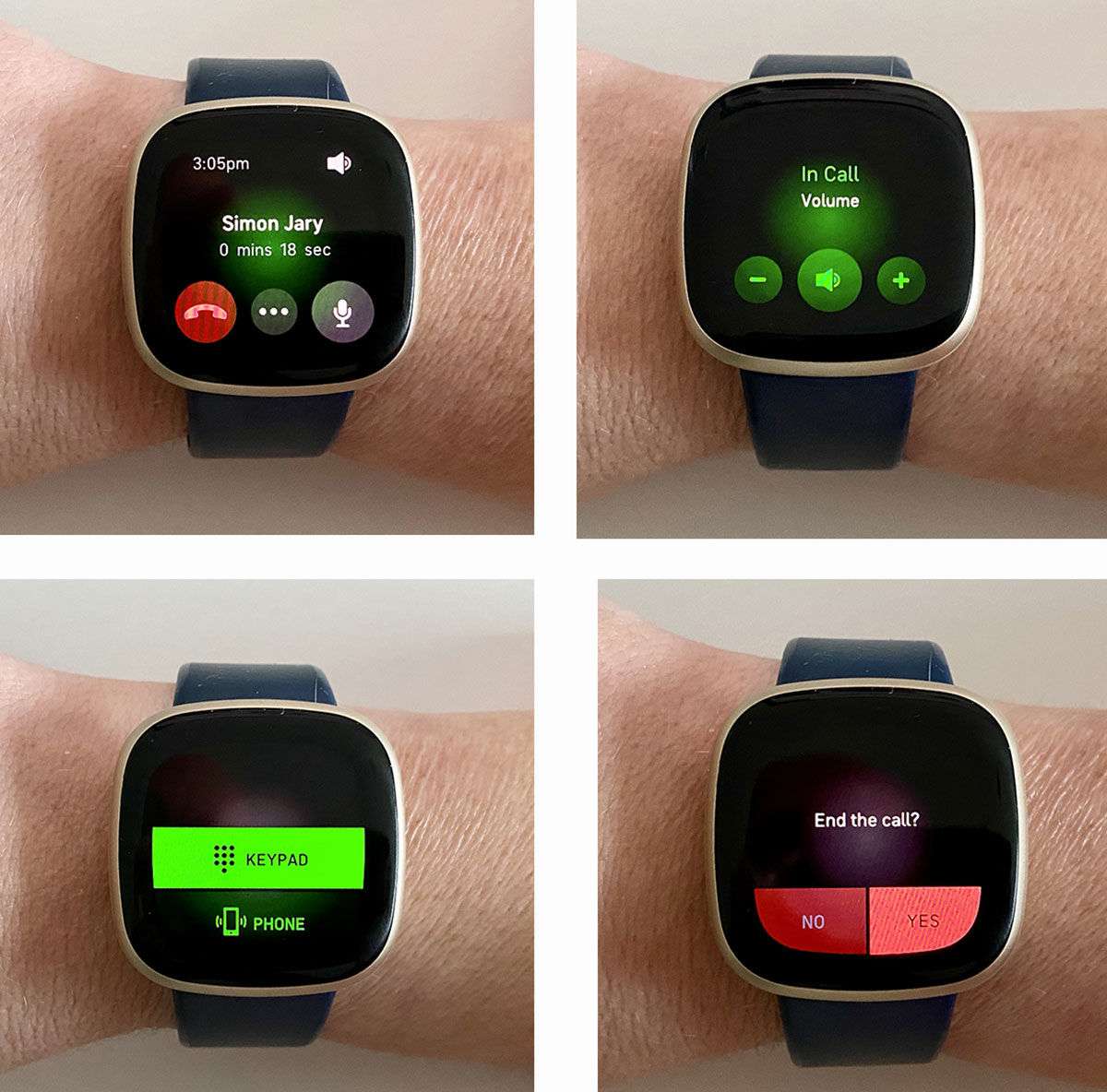
Phone calls on your wrist: Apple wins but Fitbit catching up
You can initiate and receive audio conversations on your wrist with the Apple Watch. You can even use Siri to call without using your hands by lifting your wrist and saying.
If you are wearing your Apple Watch and it is within range of your iPhone or a cellular variant that can function independently of the phone, you will be notified by a slight vibration as well as a discernible ringtone if you have not turned the device to silence.
Look at your watch to see who is calling, as well as a respond or reject option. If you want to speak with someone, press the green respond icon. You can talk without taking your iPhone out of your purse or pocket because it has a built-in speaker and microphone. If you don’t want others to hear your chat, use a Bluetooth headset or move the call from the Watch to your iPhone.
The only Fitbits with microphones are the Versa 2, 3, and 4, as well as the Sense, which uses the speaker to control Amazon’s Alexa and Google Assistant (usually a superior speech helper than Siri, but Siri on Watch can give you instructions or play you music).
You can now accept hands-free Bluetooth conversations with the Fitbit Sense and Versa’s on-device microphone and speakers, transfer inbound calls to voicemail, and adjust volume without reaching for your phone. Voice-to-text commands allow Android users to reply to text communications while on the go.
Similarly, the Apple Watch has a microphone and a speaker, allowing you to converse with it as well as converse with it. You can also use the microphone to take voice notes, transmit audio texts, and communicate with pals via the Phone app. It also has up to 32GB of storage, so you can store a collection of your favorite pictures on your wrist.
However, because the Apple Watch only works with Apple’s iPhone, Android users should consider Fitbit or other wearables from Samsung and Google’s own Pixel wristwatch.

Battery life: Fitbit wins, no contest
Because the Apple Watch has so many possible uses (calling, viewing pictures, sending and receiving texts, changing audio, checking the weather, activity tracking, digital payments, and, uh, telling the time), its battery drains much quicker than standard activity monitors.
Apple claims that the SE and Series 8 will provide up to 18 hours of active and inactive use: 90 time checks, 90 alerts, 45 minutes of continuous app use, and a 30-minute exercise with Bluetooth audio playing from the watch. So you must charge it every night unless you only use it to indicate the time, in which case it may last three days in Power Saving Mode.
According to Apple, the newest Apple Watch Ultra has a 36-hour battery life—up to 60 hours on low power levels.
As previously stated, Apple Watch’s battery life has greatly improved, and with moderate use (Activity tracking, Time, and Notifications, similar to a Fitbit), it can last nearly two full days—and, importantly, a couple of nights for sleep tracking. Apple, on the other hand, recognizes the shorter battery life by not including sleep monitoring as a built-in program.
The Apple Watch is wise in conserving its battery life. Every 15 to 20 seconds, the watch display shuts off. When you lower your arm, the screen turns dark (or dims if you have an always-on edition). The screen reappears when you lift your wrist.
You can also place it in “Power Save Mode” in the Workout app on your phone to totally disable heart-rate monitoring during runs—though this isn’t ideal for learning more about your run. Serious athletes want information before, during, and after their runs, but they don’t want to take their iPhone and Watch with them.
Fitbits have a much extended battery life, lasting about five days between refills. The Charge 5 can operate for up to a week, while the Inspire 3 can function for up to ten days. The Fitbit recharge time is approximately two hours, which is comparable to the Watch. If you use the Fitbit or Watch’s GPS frequently, the battery life will be significantly reduced. When GPS is enabled, the Fitbit will fade by 10 hours and the Watch by 5.
Anyone who has used a tracker knows how terrifying it is to be alerted to a dwindling battery. Each step must be recorded. If you overuse your Watch, it may expire during an exercise or while moving around during the day.
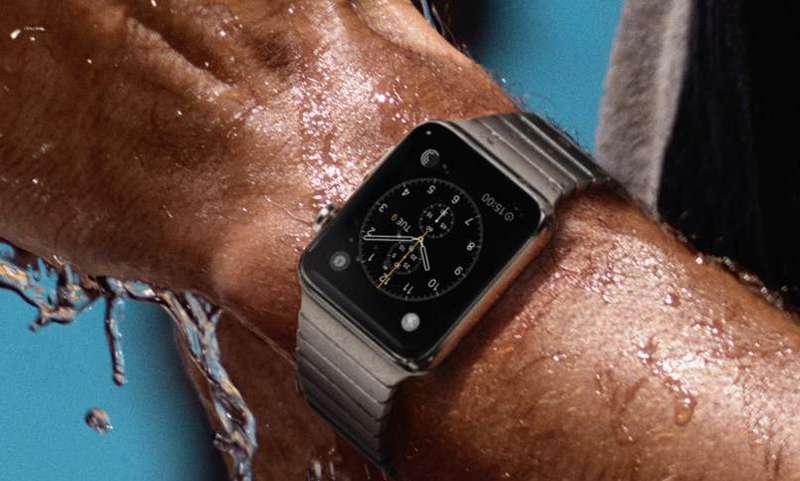
Divers fair better with the robust Apple Watch Ultra, which can reach depths of 100m (under ISO standard 22810), although Apple states that the Ultra “should not be used for diving below 40 meters”. It is ideal for snorkeling or recreational aquatic action thanks to the Depth app. It displays the time, current level, water temperature, time spent under water, and greatest depth attained.
At 5 TMA, the Fitbits are swim-proof and water-safe (50m). Fitbit also suggests removing its bracelets before bathing because, as with any wearable device, it is best for your skin if the band remains dry and clean.
Swimming monitoring tools are available on the Apple Watch and Fitbit smartwatches. A gyroscope is included in both the Watch and the Fitbit Sense for more precise pool readings.
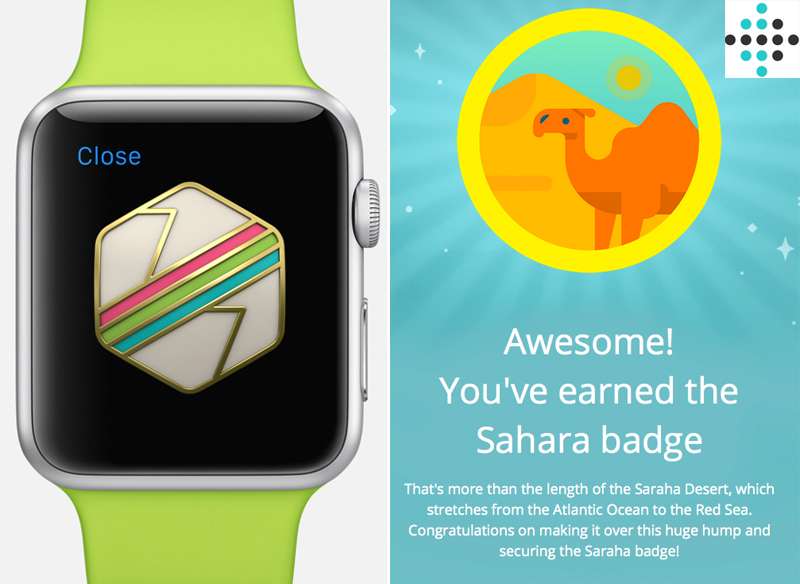
Rewards: Fitbit loses its medal, Apple wins
When Apple Watch users accomplish personal bests or landmarks, they receive a unique badge for each success, which is then saved in the Activity app on their iPhone.
Fitbit used to give out a lot of interesting medals for accomplishments, linking them to similar lengths, so you’d get a Sahara emblem after walking the comparable distance (not all in one day!).
Unfortunately, Fitbit discontinued such awards and challenges at the beginning of 2023, saying that they were rarely used.
The potential to compete against peers is a huge motivator with Fitbit (and many other fitness trackers). Walking the escalator, leaving the lift, and taking the steps is a fun way to challenge yourself a little further.
Apple Watch users can share their Activity circles with friends to keep each other inspired, but it’s not as simple as it is with Fitbit, and you’re less likely to have a slew of Watch-owning contacts unless you spend a lot of time hanging out at an Apple Store!
With Apple, you can challenge a buddy to a seven-day battle in which you both gain points by filling your Activity rings.
Apple rewards you with accomplishment medals the first time you complete new exercises, workout records, 7-workout weeks, and move objectives and runs. There are also weekly competitions.
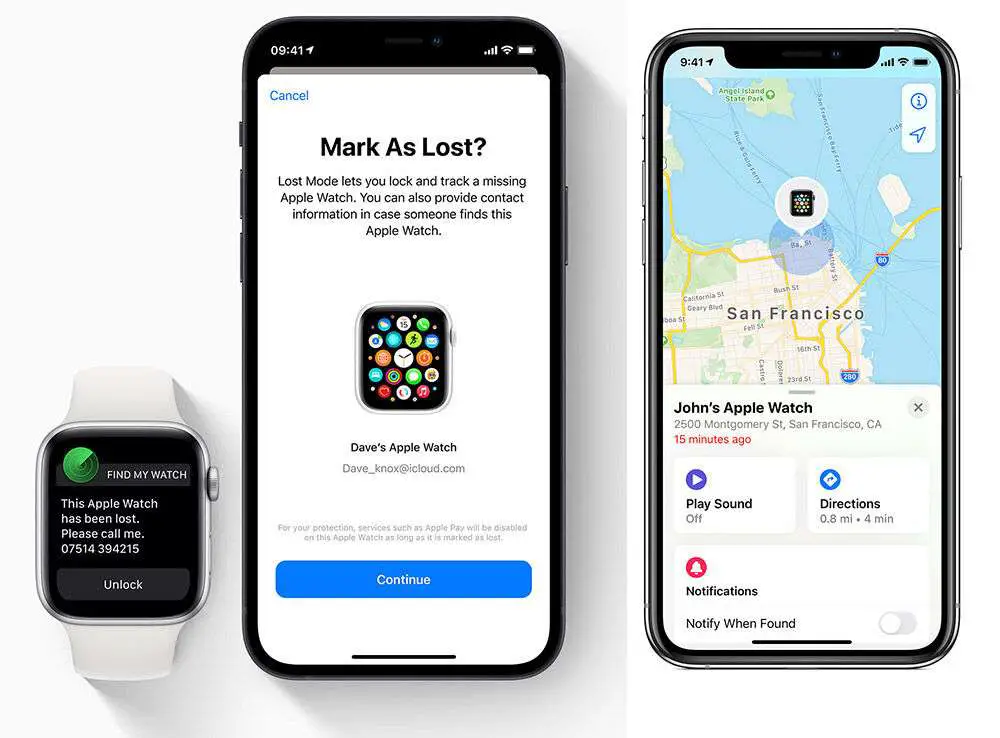
Find My…: Apple wins, Fitbit catching up
Smartwatches aren’t inexpensive, and they can be misplaced. If it slips off your wrist while you’re running, you’re unlikely to locate it on your own.
Fortunately, Apple has integrated its Locate My tech into the Apple Watch, as it has with the majority of its devices. This feature, which is activated by default, utilizes Wi-Fi or cellular networks in Locations Services to determine where your Apple device was last logged. The Apple Watch with GPS can use Satellites as well as a reliable Wi-Fi link.
When you enable Find My iPhone, your Apple Watch is immediately linked with your iPhone.
You can locate your Apple Watch devices on a map, play a sound to help you find them, show a note on a misplaced Watch, lock it until you find it, and even delete it if you don’t. If you lose your Apple Watch, you can instantly secure it using iCloud.com or your paired iPhone. You can open it once you locate it.
Most Fitbits do not support this type of device. The company recently collaborated with location specialist Tile to combine its device-finding software with the Fitbit Inspire 2 entry-level device. We hope and anticipate that Tile technology will be introduced to the other Fitbits shortly.
Other Fitbits require the software and some chance. Check the Fitbit app to see when your gadget was last connected. If it recently synced, it’s presumably within your phone’s range, so carry your phone to where you believe you lost it and attempt to sync. If you’re lucky and the Fitbit is within 30 feet Bluetooth range, it will connect, indicating that it’s close.
You can also use a Bluetooth locator software to locate your smartphone within 100 feet if its battery is still charged.
Comparing all the models: Apple Watch vs Fitbit
While the Fitbit Inspire 3 is an excellent entry-level fitness tracker, it may be too simple to compete with the Apple Watch.
The Fitbit Charge 5 does not function as a wearable. Its applications are simple, but it has been upgraded from a monochromatic to a color touchscreen. Aside from that, it’s an activity tracker with a slew of fitness and smart features, such as built-in GPS, a heart-rate monitor, automated exercise recognition, an altimeter, smartphone alerts, contactless payments, and even stress tracking. Costs begin at $149 USD / £129 GBP.
The Fitbit Versa 3 is a wearable with an excellent color touchscreen that enables brighter visuals and on-screen exercises, as well as an always-on display choice. It has a microphone and speaker for phone conversations, as well as speech tools from Alexa and Google Assistant, audio management, and some smartwatch applications. Costs begin at $169 USD / £169 GBP.
The Fitbit Versa 4 smartwatch is similar to the Versa 3, but it lacks some functions (such as third-party applications, Google Assistant, and audio control), making the Versa 3 the superior exercise smartwatch, and it’s also less expensive. Costs begin at $229 USD / £199 GBP.
The Fitbit Sense includes a slew of devices designed for both health and exercise. It has stress-reduction tools that are built on devices that detect Electrodermal Activity (EDA) and Skin Temperature. SP02 monitoring for blood oxygen and electrocardiogram (ECG) to assess your cardiac rhythm with high and low heart-rate alerts are available. Costs begin at $279 USD / £219 GBP.
The Fitbit Sense 2 has been hampered by Fitbit/Google to promote the Pixel Watch, so we favor the cheaper original version. Costs begin at $299 USD / £269 GBP.
Google, which acquired Fitbit in 2019, now has its own wearable on the market, the Pixel Watch. It has far more applications than the Fitbit Sense or Sense 2, but, despite having Fitbit features built in, it lacks the same number of health and fitness sensors as the less expensive Fitbit smartwatch. The starting price is $349 / £339.
The Apple Watch SE is the entry-level model, but it shares many features with the higher-end Apple Watch models, though it misses some health and exercise functions. It’s an excellent bargain smartwatch in 40mm or 44mm sizes for simple exercise tracking. Costs begin at $249 USD / £259 GBP.
The Apple Watch Series 8 has a larger (41mm or 45mm) touchscreen that curves around the sides and can be turned to always-on, as well as ECG, blood oxygen tracking, quicker charging, and a more sophisticated heart sensor. While the SE has an aluminum case, the 8 also has stainless steel choices, as well as more color and band variations. Costs begin at $399 USD / £419 GBP.
The Apple Watch Ultra is the best Apple Watch and comes at a premium price. It has a larger, brighter 49mm monitor (410 x 502 pixels) and is constructed of titanium, making it extremely durable. While it does not equal Fitbit’s battery life, its 36-hour durability outlasts the SE and 8’s 18-hour duration. It is waterproof to 100m, as opposed to the other Watch and Fitbits, which can only reach 50m, making it a superior choice for swimmers. Its GPS is more precise than that of the other wearables we’ve looked at. Costs begin at $799 / £849.

Price: Apple getting cheaper
Of course, money is an essential consideration when deciding between Fitbit and Apple Watch.
Nobody ever accused Apple of offering low-quality goods. Its ability to turn the most costly goods in the industry into best-sellers is what has made it one of the world’s wealthiest firms. And, while not the most costly timepiece in the world, the Apple Watch is the most expensive smartwatch.
However, Apple has now reduced the price of the entry-level Apple Watch to that of a Fitbit wearable. Fitbit still has much less expensive choices for monitors that aren’t smartwatches.
The Apple Watch SE is the entry-level Apple Watch, costing $249 / £259 for the 40mm edition and $279 / £299 for the 44mm model, with the cellular device costing an additional $50 / £60.
Series 8 Apple Watches are significantly more expensive, beginning at US$399 / £419 for the 41mm model, with the steel variant costing significantly more (from $699 / £729), and the cellular edition of each also costs more (US$499 / £529 for the aluminum body).
The Apple Watch Ultra is on another plane, but not far from the stainless Series 8, which starts at $799 (£849).
Buy at the Apple Store US, Apple Store UK or Apple Store AU.
Fitbit bracelets begin at $99 USD / £84 GBP for the Fitbit Inspire 3. Fitbit Charge 5 costs $149 / £129, Fitbit Versa 3 costs $169 / £169, and Fitbit Sense costs $279 / £219. Don’t trouble with the less costly but less capable Versa 4 or Sense 2.
Even the most costly Fitbit costs roughly the same as the most affordable Apple Watch—even the Watch SE. It’s worth noting that you can often get a Fitbit for less money online from retailers like Amazon, whereas Apple rarely provides deals.
Of course, the Apple Watch provides a lot more utility for your money, but if you’re looking for exercise tracking, a Fitbit will save you a lot of money.

Compatibility: Apple is iPhone only
Fitbit is available for both iOS and Android. Fitbit doesn’t require a smartphone to function because it can connect with the great desktop Fitbit Dashboard, but it’s nice to have more syncing options and be able to see some fancy metrics and diagrams on the go.
While only the Versa 3 and Sense smartwatches can operate applications, these Fitbit wristbands can connect to apps like MapMyRun, MyFitnessPal, Runkeeper, Endomondo, Strava, and others. When it comes to third-party applications, the later Versa 4 and Sense 2 are extremely limited.
As you might expect, Google’s Pixel Watch is only available for Android.
Because Apple Watch is only functional with iOS devices, the iPhone is the only smartphone that will operate with it, and you really need one to make it work.
Other exercise applications that can be operated on the Apple Watch include Nike+Run Club, Runtastic Pro, Pocket Yoga, Map My Run, Endomondo, and Cyclemeter GPS, with more being added all the time.
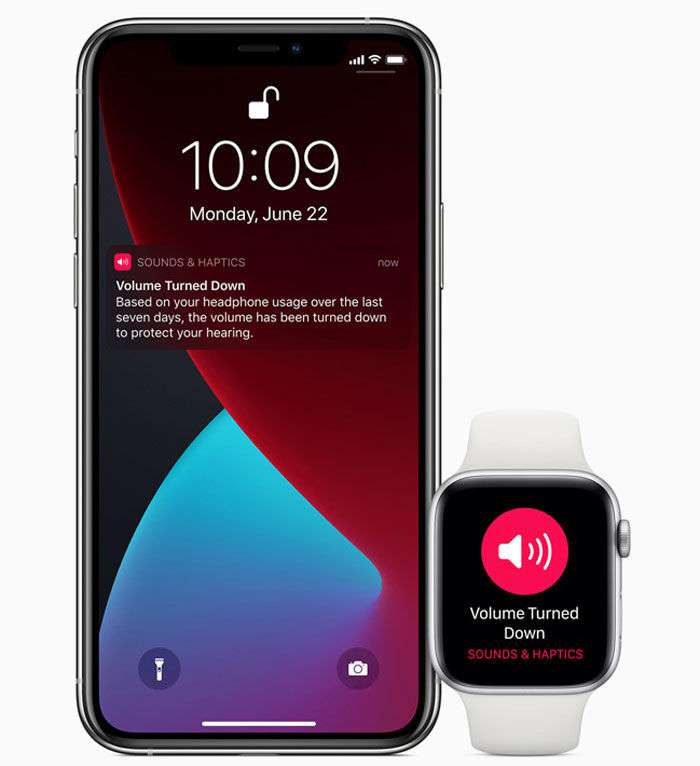
Hearing: Apple wins helping your ears
In watchOS 6, Apple debuted the Noise app, which tracks ambient sound levels and exposure time. With headphone aural alerts, watchOS 7 improved hearing health even more.
This will display how loudly you are listening to music through your headphones when using an iPhone, iPod touch, or Apple Watch, as well as how these amounts may affect your hearing over time.
Apple will notify you when your hearing has hit 100% of the World Health Organization’s safe weekly listening level.
The Health software can even set the utmost volume for headphones.
Fitbit Premium vs Apple Fitness+
Both Apple and Fitbit have paid subscriber services that include additional features, statistics, and customized observations.
Apple’s Fitness+, as the name suggests, is primarily concerned with exercises and fitness, whereas Fitbit Premium is concerned with fitness, health, diet, and overall well-being.
Apple’s Fitness+ subscription program is still in its early stages. It costs $9.99/£9.99/month or $79.99/£79.99/year. Fitness+ can be shared for the same fee by up to six family members. When you purchase an Apple Watch, you will receive three months of Fitness+ for free.
It contains home exercise programs that supplement the Watch’s health features by tracking your movement in addition to workout films that can be viewed on your iPhone, iPad, or AppleTV.
High-Intensity Interval Training (HIIT), Strength, Yoga, Dance, Core, Cycling, Treadmill (for jogging and strolling), Rowing, and Thoughtful Cooldown are all workout groups.
Virtual coaches customize the exercise to your specific needs.
You can view your exercise data after the activity, such as pulse rate, duration, pace, and calories expended. The Watch’s Activity ring is reflected on the workout’s video screen as you strike different objectives.
Fitbit Premium has been around for a while and provides much more than just exercises, such as tailored programs to help you remain active, consume and sleep well, and handle stress.
It costs $9.99 / £7.99 per month or $79.99 / £79.99 per year, making it slightly less expensive in the UK when purchased monthly.
It includes video and voice exercises (walking, weights, aerobic, dance, martial arts, yoga, and more) that can be watched on your phone through the Fitbit app, and some that can be viewed on your Fitbit watch.
Members receive customized views, a summary of their Sleep Score, and a Wellness Report based on their data. There are also tasks available only to Elite members.
Fitbit Premium is available for a three-month free trial, and new customers receive free Premium when purchasing a tracker or wearable, up to a year’s worth with the Fitbit Inspire 2, and does not offer a family subscription choice.
Also they provides a Fitbit Premium & Health Counseling subscription (currently only available in the United States) for $54.99 per month. With unlimited in-app messaging and data-driven advice, you can work one-on-one with an expert health coach to get personalized help and a tailored action plan.
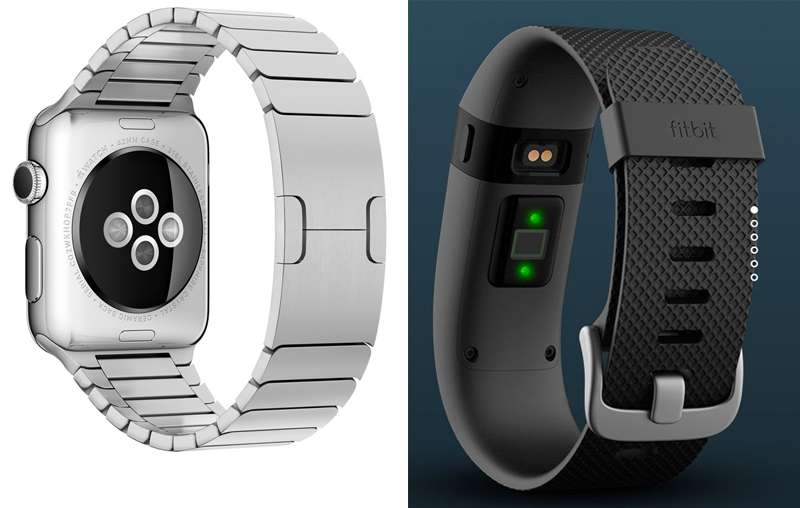
Which should you buy: Fitbit or Apple Watch?
If health is your main concern, we believe the Fitbit devices come out on top (particularly if you participate in multiple sports), but the Apple Watch, of course, provides much more than just activity tracking and heart-rate monitoring.
The growing software ecosystem for the Apple Watch will make the device far more flexible than a specialized fitness band. And, despite its improved but relatively bad battery life, the new Apple Watch Series 6 with built-in GPS and 4G is a significant step forward in Apple’s creation of a true activity tracker.
However, this comes at a high cost.
Fitbits have much longer battery lives (the Charge 5 can last up to a week! ), so they don’t need to be charged every night while you sleep. Only the pricey Apple Watch Extreme comes close with a day and a half.
Detailed sleep tracking can be nearly as informative about one’s health as a daily exercise regimen. While Apple has added a Sleep app, the shorter battery life makes this difficult for users. Sleep monitoring is much simpler on the Fitbit, though Fitbit does conceal some data for its Premium users.
We also appreciate the incentive provided by Fitbit’s Friends division.
Most importantly, if you own an Android, the Apple Watch is simply not for you. It’s essentially worthless without an iPhone.
Apple Watch owners do not need to purchase a Fitbit in addition to their treasured digital timepiece, but runners and fitness enthusiasts should consider adding third-party applications or a specialized sports watch from Garmin, Suunto, or Polar, or check out the Ionic.
Of course, one significant benefit of the Apple Watch is its ability to make and receive phone calls, which is only equaled by the Fitbit Versa 3 & 4 and the Sense 1 & 2.
So, while Fitbits win for fitness and activity tracking, we applaud Apple for the Watch’s fitness apps, which should encourage Watch owners to get up and move around more – something that all of us gadget owners could use to keep us from slipping into unhealthy lifestyles.


